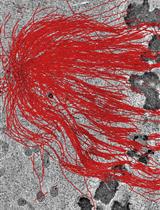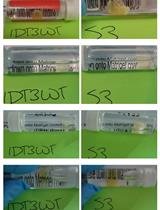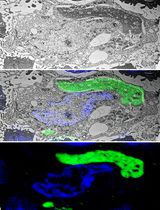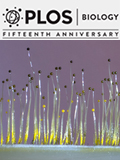- Submit a Protocol
- Receive Our Alerts
- Log in
- /
- Sign up
- My Bio Page
- Edit My Profile
- Change Password
- Log Out
- EN
- EN - English
- CN - 中文
- Protocols
- Articles and Issues
- For Authors
- About
- Become a Reviewer
- EN - English
- CN - 中文
- Home
- Protocols
- Articles and Issues
- For Authors
- About
- Become a Reviewer
Electron Microscopic Detection of Proteins and Protein Complexes in Mammalian Cells Using APEX-tagged, Conditionally Stable Nanobodies
(*contributed equally to this work) Published: Vol 8, Iss 22, Nov 20, 2018 DOI: 10.21769/BioProtoc.3088 Views: 5725
Reviewed by: Amey RedkarAnna Maria Ochocka-FoxHolger Andreas Russ

Protocol Collections
Comprehensive collections of detailed, peer-reviewed protocols focusing on specific topics
Related protocols

Serial-section Electron Tomography and Quantitative Analysis of Microtubule Organization in 3D-reconstructed Mitotic Spindles
Robert Kiewisz [...] Gunar Fabig
Oct 20, 2023 1837 Views

Simple Rescue of Opaque Tissue Previously Cleared by iDISCO
Haylee Mesa [...] Qi Zhang
Mar 5, 2024 1670 Views

A Step-By-Step Protocol for Correlative Light and Electron Microscopy Imaging of Proteinaceous Deposits in Cultured Cells and Human Brain Tissues
Peizhou Jiang and Dennis W. Dickson
Aug 5, 2025 1679 Views
Abstract
The recent development of 3D electron microscopic techniques for cells and tissues has necessitated the development of new methods for the detection of proteins and protein-complexes in situ. The development of new genetic tags, such as the ascorbate peroxidase, APEX, for electron microscopic detection of tagged proteins has expanded the available toolbox and ushered in a new era in biological electron microscopy. Here, we describe methods for combining conditionally-stable nanobodies to fluorescent protein tags with APEX-based detection. These methods are compatible with detection of low levels of expression of fluorescently-tagged proteins and with detection of protein complexes using split GFP-based complementation methods. We describe a simple protocol for applying these methods to the electron microscopic detection of proteins and protein complexes in cultured cells.
Keywords: Electron microscopyBackground
Recently, we developed a system for the detection of GFP-labeled proteins in transfected cells by electron microscopy (Ariotti et al., 2015). This simple system involves the co-transfection of a plasmid encoding a GFP binding nanobody; a small, genetically encodable, single chain antibody (Kubala et al., 2010), fused to an ascorbate peroxidase APEX2-tag (Martell et al., 2012), which is able to catalyze a reaction to produce a precipitate visible in the electron microscope. More recently, we have expanded the scope of this methodology with i) the addition of an mCherry-binding nanobody allowing detection of mCherry-tagged proteins, ii) the adoption of conditionally stable nanobody sequences and iii) the application to bimolecular fluorescence complementation (Hu et al., 2002), allowing detection of pairwise interactions at the ultrastructural level (Ariotti et al., 2018).
Materials and Reagents
- 9.2 cm2 (40 mm diameter) tissue culture dishes (TPP, supplied by Sigma-Aldrich, catalog number: 93040)
- Gloves
- 0.2 µm syringe filter
- 3 slot grids (Ted Pella, catalog number: 01816) (Figure 1)

Figure 1. 3 slot grids - APEX2-csGBP vector (Addgene, catalog number: 108874) (store at -20 °C)
- mKate2-P2A-APEX2-csGBP vector (Addgene, catalog number: 108875) (store at -20 °C)
- APEX2-csChBP vector (Addgene, catalog number: 108876) (store at -20 °C)
- EGFP-P2A-APEX2-csChBP vector (Addgene, catalog number: 108877) (store at -20 °C)
- mVenus-N vector with insert of choice cloned into EcoRV/SpeI (Addgene, catalog number: 108887) (store at -20 °C)
- mVenus-C vector with insert of choice cloned into EcoRV/SpeI (Addgene, catalog number: 108888) (store at -20 °C)
- Lipofectamine 3000 (Life Technologies, catalog number: L3000015) (store at 4 °C)
- Bovine hemin (Sigma-Aldrich, catalog number: H9039) (store at 4 °C)
- 3,3'-diaminobenzidine tetrahydrochloride (DAB) (Sigma-Aldrich, catalog number: D4168) (store at -20 °C)
- Glutaraldehyde (Electron Microscopy Sciences, catalog number: 16220) (store at 4 °C)
- Hydrogen peroxide (Sigma-Aldrich, catalog number: H1009) (store at 4 °C)
- Osmium tetroxide (OsO4) (ProSciTech, catalog number: C010) (store at 4 °C). Acutely toxic and corrosive.
- LX112 resin kit (Ladd Research, catalog number: 21310) (store at -20 °C when made up)
- Sodium cacodylate trihydrate (Sigma-Aldrich, catalog number: C0250) (store at 4 °C)
- Ethanol (Chem-supply, catalog number: EA043-2.5L-P)
- Hydrochloric Acid 32% (RCI, catalog number: RP1104)
- NaOH
- KCl
- Na2HPO4
- KH2PO4
- NaCl
- Bovine hemin (if necessary) (see Recipes)
- PBS, pH 7.4 (see Recipes)
- 2.5% glutaraldehyde in 0.1 M cacodylate buffer (see Recipes)
- 0.2 M cacodylate buffer (see Recipes)
- DAB/Cacodylate wash mixture and DAB/cacodylate reaction mixture (see Recipes)
- Osmium tetroxide solution (see Recipes)
- Ethanol series for dehydration (see Recipes)
- LX112 resin ethanol series (see Recipes)
Equipment
- Pliers (JBS, catalog number: 00718811) or similar
- Oven (SEM, model: 24) or similar
- PELCO Biowave with PELCO ColdSpot Pro system for temperature control (Ted Pella) (Figure 2)

Figure 2. PELCO Biowave - JEM-1011 Transmission Electron Microscope (JEOL) or similar
- Leica EM UC6 Ultramicrotome (Leica Microsystems) or similar
- Morada CCD camera (Olympus Soft-Imaging-Solutions) or similar (Figure 3)

Figure 3. JEM-1011 electron microscope (left), Leica EM U6 Ultramicrotome (middle), Morada CCD camera (right) - 45° diamond knife (Diatome, supplied by Agar Scientific, catalog number: AGG339-5) (Figure 4)

Figure 4. 45° diamond knife - Project specific tissue culture equipment such as a class II biological safety cabinet, CO2 incubator etc.
- Fume hood
- Vortex
Software
- iTEM (EMSIS GmbH) v5.2, build 4768, license required, https://www.emsis.eu/products/software/item
- Photoshop CC (Adobe), license required, https://www.adobe.com/au/creativecloud.html
Procedure
- After trypsinization, seed cells onto TPP dishes to achieve a confluence of 60%-90% at the time of transfection (Figure 5).

Figure 5. Timeline of the procedure. The entire process usually takes four days, including an overnight incubation post-transfection. In highly expressing cell lines such as BHK, our most commonly used line, this can be shortened to three days by reducing the post-transfection incubation step. Expression level can be empirically determined by fluorescence. - Perform transfection using Lipofectamine 3000 with a 1:1 ratio of plasmid encoding cs-nanobody-APEX (Addgene 108874 or 108876), together with the following as required; plasmid encoding GFP- or mCherry-tagged protein of interest; plasmids encoding the putative interacting proteins of interest fused to the N- or C- terminal constructs of split GFP; appropriate control plasmids. To control for non-specific APEX labeling, as a minimum, we use one half of the split-GFP pair only (N or C) with the APEX-csGBP plasmid. Additional controls can be i) no transfection; ii) APEX-csGBP only; iii) known proteins that do not interact; iv) proteins of interest with the interacting domains rendered non-functional by mutagenesis (if this information is known, this is the ideal control). One microgram of each plasmid per 3 cm dish is used as standard.
- Incubate for 3 h, and then replace the culture medium. Incubate for a further 24 h. Note that certain cell types require addition of exogenous heme for maximal APEX activity. If necessary add bovine hemin to a final concentration of 7 µM 16 h or more prior to fixation.
- Remove the medium from the cells and wash 3 times with phosphate buffered saline (PBS) for 2 min each (note that all washes are 3 ml per dish). Fix in 2.5% glutaraldehyde in 0.1 M cacodylate buffer for 30 min at room temperature. Wash three times in 0.1 M sodium cacodylate buffer (5 min each at RT). It is critical to perform the DAB reaction immediately after fixation. The DAB/cacodylate reaction and wash mixtures should be prepared during the fixation period.
- Wash for 2 min in DAB/cacodylate wash mixture. Replace with DAB/cacodylate reaction mixture (containing hydrogen peroxide) and incubate at room temperature for 30 min. Wash 3 times for 5 min with 0.1 M sodium cacodylate to remove free DAB.
- Post-fix in Osmium tetroxide solution for 2 min to convert the DAB reaction product into an electron dense stain. Wash three times each for 2 min in 0.1 M cacodylate buffer and an additional three times in double distilled H2O.
- Perform serial dehydration with increasing concentrations of ethanol in a PELCO BioWave fitted with a PELCO ColdSpot Pro system at 250 W (40 s incubation in 30% ethanol followed by 50%, 70%, 90% and 2 x 100%).
- Serially infiltrate with increasing concentrations (25%, 50%, 75% and 2 x 100%) of LX112 resin in ethanol in the Biowave at 250 W under vacuum for 3 min per step.
Note: Dehydration and infiltration steps can be performed without the use of a microwave by increasing dehydration steps to 10 min each and resin infiltration steps to 60 min incubations with an overnight incubation for the final 100% step. - Polymerize at 60 °C for 16-24 h. Separate the plastic tissue culture dish from resin embedded cells with pliers and prepare blocks for sectioning (Figure 6).

Figure 6. Resin embedded cells in blocks are separated from the plastic tissue culture dish (A) and mounted in the microtome chuck (B) - Cut 60 nm sections using an ultramicrotome and a 45° diamond knife. Place sections on EM grids (e.g., formvar and carbon coated triple slot grids).
- Image under the electron microscope at 80 kV, beginning at low magnification (~x200) to find an area of interest before bringing in the objective aperture and gradually moving to a higher magnification as needed. For examples of staining, please see Ariotti et al. (2015).
Notes
- The degradation of conditionally-stable nanobodies in the absence of their binding partners relies on efficient proteasomal degradation. The efficiency of proteasomal degradation is known to vary from cell type to cell type. We have also observed that in some cells a low level of residual staining for APEX can be seen in control cells (lacking GFP or mCherry fluorescent proteins) expressing conditionally-stable nanobodies. It is therefore essential that controls be always performed in parallel to establish the level of APEX-DAB staining in cells lacking the binding partners for the cs-nanobodies.
- Heme is an essential cofactor for the APEX ascorbate peroxidase, and certain cell types require addition of bovine hemin to the culture media prior to fixation to enhance APEX2 activity (Martell et al., 2012). However, some cell lines contain sufficient free heme such that addition to the culture medium is not necessary. To date, we have performed APEX labeling on BHK, HeLa and Caco2 cells without heme supplementation and do not now add additional heme as part of our standard procedure.
- Osmium tetroxide is acutely toxic, corrosive, and requires specialist disposal. It should only be used with appropriate containment (e.g., fume hood) and PPE (e.g., gloves), after checking institutional policy and the current MSDS.
Recipes
- Bovine hemin (if necessary)
483 µM bovine hemin in 0.01 N NaOH
Vortex vigorously to dissolve - PBS, pH 7.4
2.7 mM KCl
10 mM Na2HPO4
1.8 mM KH2PO4
137 mM NaCl - 2.5% glutaraldehyde in 0.1 M cacodylate buffer
Combine 25% glutaraldehyde and 0.2 M cacodylate buffer to the working concentrations - 0.2 M cacodylate buffer
Dissolve 4.28 g sodium cacodylate in 100 ml water
Adjust pH to 7.4 using 0.2 N HCl (approx. 5.5 ml) - DAB/Cacodylate wash mixture and DAB/cacodylate reaction mixture
- Dissolve DAB tablets to a concentration of 2 mg/ml with vigorous vortexing for 5 min
- Add 0.2 M sodium cacodylate buffer to a final concentration of 0.1 M sodium cacodylate and 1 mg/ml DAB
- Vortex for a further 5 min and filter using a 0.2 µm syringe filter
- Divide the mixture into two aliquots; to one add hydrogen peroxide to a final concentration of 5.88 mM (DAB/cacodylate reaction mixture). The aliquot without hydrogen peroxide is the DAB/cacodylate wash mixture
- Osmium tetroxide solution
1% OsO4 in 0.1 M sodium cacodylate buffer - Ethanol series for dehydration
30%, 50%, 70%, 90%, and 100% - LX112 resin ethanol series
25%, 50%, 75% and 100% LX112 in ethanol
Acknowledgments
This work was supported by grants and a fellowship from the National Health and Medical Research Council of Australia (grant numbers APP1037320, APP1058565, and APP569542 to RGP; APP1045092 to RGP and NA; APP1099251 to TEH and RGP).
The use of APEX for EM is based on the development and application of APEX2 as described by Lam et al. (2015). Destabilized nanobodies are based on the studies of Tang et al. (2016).
Competing interests
The authors declare that they have no conflicts of interest and no competing interests.
References
- Ariotti, N., Hall, T. E., Rae, J., Ferguson, C., McMahon, K. A., Martel, N., Webb, R. E., Webb, R. I., Teasdale, R. D. and Parton, R. G. (2015). Modular detection of GFP-labeled proteins for rapid screening by electron microscopy in cells and organisms. Dev Cell 35(4): 513-525.
- Ariotti, N., Rae, J., Giles, N., Martel, N., Sierecki, E., Gambin, Y., Hall, T. E. and Parton, R. G. (2018). Ultrastructural localisation of protein interactions using conditionally stable nanobodies. PLoS Biol 16(4): e2005473.
- Hu, C. D., Chinenov, Y. and Kerppola, T. K. (2002). Visualization of interactions among bZIP and Rel family proteins in living cells using bimolecular fluorescence complementation. Mol Cell 9(4): 789-798.
- Kubala, M. H., Kovtun, O., Alexandrov, K. and Collins, B. M. (2010). Structural and thermodynamic analysis of the GFP: GFP-nanobody complex. Protein Sci 19(12): 2389-2401.
- Lam, S. S., Martell, J. D., Kamer, K. J., Deerinck, T. J., Ellisman, M. H., Mootha, V. K. and Ting, A. Y. (2015). Directed evolution of APEX2 for electron microscopy and proximity labeling. Nat Methods 12(1): 51-54.
- Martell, J. D., Deerinck, T. J., Sancak, Y., Poulos, T. L., Mootha, V. K., Sosinsky, G. E., Ellisman, M. H. and Ting, A. Y. (2012). Engineered ascorbate peroxidase as a genetically encoded reporter for electron microscopy. Nat Biotechnol 30(11): 1143-1148.
- Tang, J. C., Drokhlyansky, E., Etemad, B., Rudolph, S., Guo, B., Wang, S., Ellis, E. G., Li, J. Z. and Cepko, C. L. (2016). Detection and manipulation of live antigen-expressing cells using conditionally stable nanobodies. Elife 5: e15312.
Article Information
Copyright
© 2018 The Authors; exclusive licensee Bio-protocol LLC.
How to cite
Hall, T. E., Rae, J., Ariotti, N. and Parton, R. G. (2018). Electron Microscopic Detection of Proteins and Protein Complexes in Mammalian Cells Using APEX-tagged, Conditionally Stable Nanobodies. Bio-protocol 8(22): e3088. DOI: 10.21769/BioProtoc.3088.
Category
Developmental Biology > Morphogenesis > Cell structure
Cell Biology > Cell imaging > Electron microscopy
Cell Biology > Cell imaging > Fixed-tissue imaging
Do you have any questions about this protocol?
Post your question to gather feedback from the community. We will also invite the authors of this article to respond.
Tips for asking effective questions
+ Description
Write a detailed description. Include all information that will help others answer your question including experimental processes, conditions, and relevant images.
Share
Bluesky
X
Copy link








